Waikanaloa Caves
Dry Cave - Wet Cave - Waikapala’e Cave
Useful Information
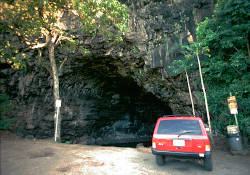
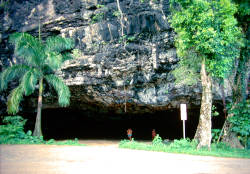
| Location: |
At the end of Hwy 560, Kuhio Highway, Northern Kauai, Hawaii.
Hāʻena State Park.
Dry Cave: on the left side of the road, before Mile Marker #9, across the street from the Ha’ena Beach Park. Wet Cave: on the left side of the road, before Mile Marker #10, past the Ha’ena Beach Park. Waikapala’e Cave: on the left side of the road, before Mile Marker #10, past the Ha’ena Beach Park, follow a short trail uphill. (22.2203635, -159.5805949) |
| Open: |
All year daily 7-6:45. [2020] |
| Fee: |
Caves: free. Park Fee: Non-Residents USD 5, Residents free. Parking: Non-Residents USD 10, Residents free. [2020] |
| Classification: |
 Sea Cave Sea Cave
|
| Dimension: | Dry Cave: L=100 m, W=50 m, H=10 m. |
| Photography: | allowed |
| Accessibility: | no |
| Bibliography: | |
| Address: | Department of Land and Natural Resources, Division of State Parks, 3060 Eiwa Street, Suite 306, Lihue, Hawai‘i 96766, Tel: +1-808-274-3444. |
| As far as we know this information was accurate when it was published (see years in brackets), but may have changed since then. Please check rates and details directly with the companies in question if you need more recent info. |
|
History
| 1957 | the tsunami filled the Dry Cave partially with sand. |
| APR-2018 | severe flood destroys road past Hanalei. |
| JUN-2019 | road reopened. |
Description
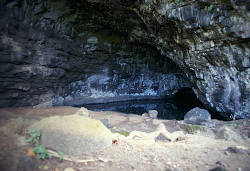
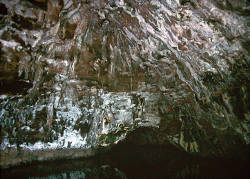
Waikanaloa Caves are three small caves at the end of the highway 560, which can be easily visited. They are located at the Haena State Park which is quite popular among locals and tourists for its beach. Kēʻē Beach has a reef 100 m in front of the beach which breaks the huge Pacific waves and makes bathing and swimming much safer. There are no undercurrents which could drag you out into the sea. Unfortunately this means that the parking lot is full almost every day. Hā’ena is also home to the trailhead of the world famous Kalalau Trail and the Hanakāpīʻai Falls trail.
Due to a severe flood in April 2018 there were restrictions for repairs and maintenance. As a result there were shuttles from Hanalei which were booked out two weeks in advance. The good thing was that the closure enabled the Division of State Parks to implement the Hāʻena Master Plan. This includes the restoration of the damages caused by decades of uncontrolled use. But it also means daily visitor limits and advanced online reservations are required to enter the park. For non-residents there is now a day use fee. The road is reopened since June 2019.
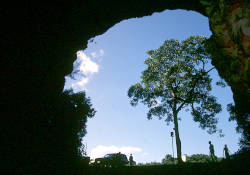
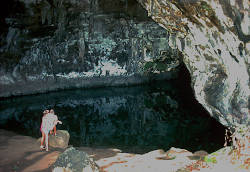
Wet cave or Waikanaloa Cave is a sea cave which contains a small freshwater lake.
The freshwater comes down through the basalt layers from behind.
The cave is quite short, the water begins only 10 m from the portal, and the portal is quite huge.
A big sign warns visitors not to swim in this water because of the danger of
 Leptospirosis, a dangerous bacteria which is common in Hawai’i freshwater.
So we can not recommend any kind of exploration in the water.
Leptospirosis, a dangerous bacteria which is common in Hawai’i freshwater.
So we can not recommend any kind of exploration in the water.
In Hawai’i, like in other tropical countires, there is a legend about leptospirosis. They tell that standing water is dangerous while flowing water is okay. And as the cave lake is standing there is no brook or river, the water is not suitable for drinking or even for bathing. While the fact that the standing water is dangerous is true, the opposite is not. There is actually no reason why flowing water should be less dangerous. The only point is that flowing water from rain has not enough time to be contaminated before it reaches the sea. On the other hand any brook which is formed by the outflow of a cave lake will be as contaminates as the cave lake itself.
The cave is located only a few meters from the road and is signposted. Once there was the possibility to park for 10 minutes while visiting the cave. However, the park was lately refurbished so you should definitely check for new traffic signs.
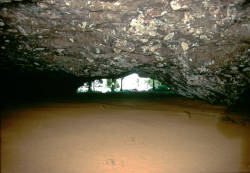
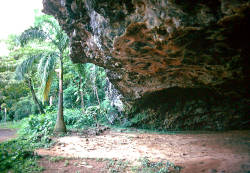
Dry cave or Manini Holo is a three metre high, 50 m wide and 100 m deep sea cave. The floor is dry sand from the beach, brought in by a 1957 Tsunami, hence the name. It was formed, when the island was a few meters lower, and the cliff above the cave was the coast line. This was probably 4,000 years ago, the subsequent uplift was caused by the volcanic activities of the island. The cave is located 100 m before the road ends at Ha’ena Beach, right at the roadside. It is also called Manini-holo Dry Cave after the legend of Manini-holo (also written Maniniholo), the chief fisherman of the Menehune (little people).
Maniniholo used to catch many fish at Ha’ena beach.
On one account, after catching lots of fish, he was not able to carry all and left some of the catch under the cliff.
The menehune carried the first batch of fish to the island’s interior where the other menehune lived.
But when they returned to gather the rest of the fish, they saw an akua, a supernatural beast or spirit, who stole the fish.
In order to catch the akua they dug a cave and made a trap.
This cave is the remains of their trap.
Other legends say that the menehune dug the cave looking for imps that stole their fish.
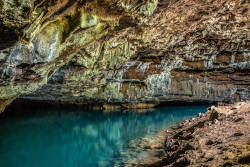
The third cave, Waikapala’e Cave or Blue Room Wet cave is not this easy to find.
It is 5 minutes walk up the hill from Wet cave, but there are no signs.
But there are signs in front of the cave, the same as at Waikanaloa cave, the water is dangerous for
 Leptospirosis.
Unfortunately this means, that it is not possible to see the main feature of this cave, the Blue Room.
At the back of the main cave is a small opening into a second, smaller room accessible only by swimming through the ice cold water.
The sunlight reflected by the water fills the room with blue light.
This works best during high tide, as the water level is effected by the tide.
The higher water level in the cave narrows the opening and so less sunlight falls directly into the cave intensifying the blue light effect.
We warn to swim into the cave because of the danger of leptospirosis.
However, if you do it anyway be aware that the water is very cold, and there is no floor in the "Blue Room" and nothing to hold on, so you will have to tread water the entire time.
We recommend reef shoes because of the slippery lava rock.
Leptospirosis.
Unfortunately this means, that it is not possible to see the main feature of this cave, the Blue Room.
At the back of the main cave is a small opening into a second, smaller room accessible only by swimming through the ice cold water.
The sunlight reflected by the water fills the room with blue light.
This works best during high tide, as the water level is effected by the tide.
The higher water level in the cave narrows the opening and so less sunlight falls directly into the cave intensifying the blue light effect.
We warn to swim into the cave because of the danger of leptospirosis.
However, if you do it anyway be aware that the water is very cold, and there is no floor in the "Blue Room" and nothing to hold on, so you will have to tread water the entire time.
We recommend reef shoes because of the slippery lava rock.
Normal water works as a filter for light, only the blue wavelength gets through, the other colours are absorbed. This effect is intensified if there is dissolved limestone in the water. However, there is no limestone, only basaltic rocks of volcanic origin. But even in basaltic rocks there is calcium, and the sand of the beach in front consists of shattered corals which are mostly made of limestone. The sand was probably blown in by the wind. Those minerals are in the water and create the blue hue, which is more intense when the light is brighter. Unfortunately the cave opens to the north, and there is never direct sunlight on the water.

|
| Waikanaloa Caves Gallery |
- See also
 Search DuckDuckGo for "Waikanaloa Cave"
Search DuckDuckGo for "Waikanaloa Cave" Google Earth Placemark: Dry Cave
Google Earth Placemark: Dry Cave Google Earth Placemark: Wet Cave
Google Earth Placemark: Wet Cave Google Earth Placemark: Waikapala’e Cave
Google Earth Placemark: Waikapala’e Cave OpenStreetMap
OpenStreetMap Hāʻena State Park, official website (visited: 17-NOV-2020)
Hāʻena State Park, official website (visited: 17-NOV-2020) The Blue Room - Atlas Obscura (visited: 17-NOV-2020)
The Blue Room - Atlas Obscura (visited: 17-NOV-2020) Kauai, Hawaii: Cave at Haena Beach, viewed from outside and inside
Kauai, Hawaii: Cave at Haena Beach, viewed from outside and inside Manini-holo Dry Cave
Manini-holo Dry Cave Maniniholo Dry Cave, Haena Beach Park (visited: 05-APR-2020)
Maniniholo Dry Cave, Haena Beach Park (visited: 05-APR-2020)
 Index
Index Topics
Topics Hierarchical
Hierarchical Countries
Countries Maps
Maps